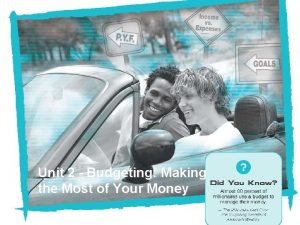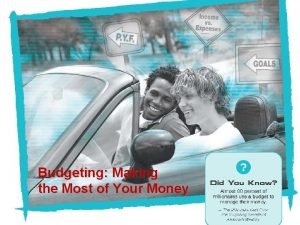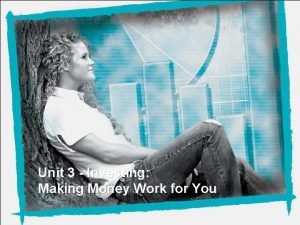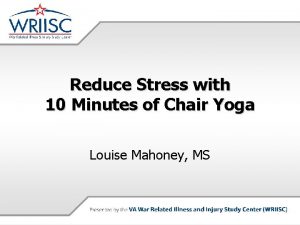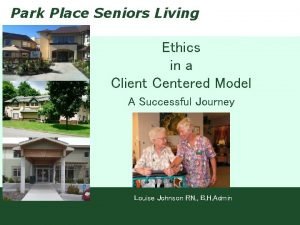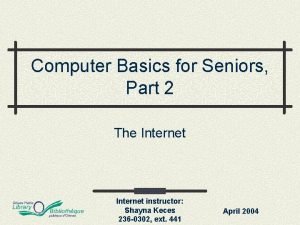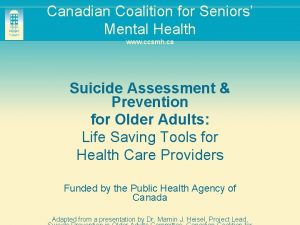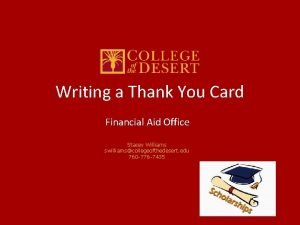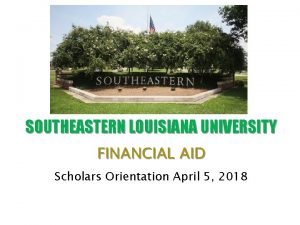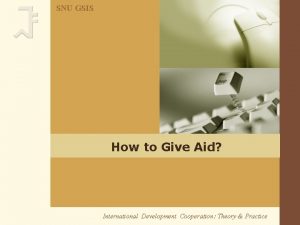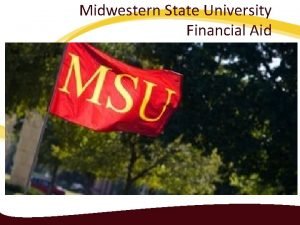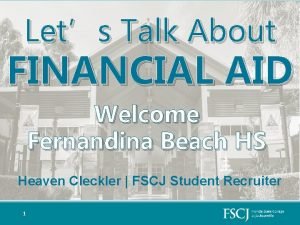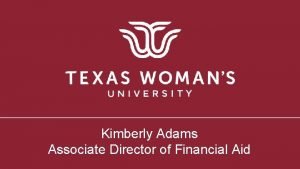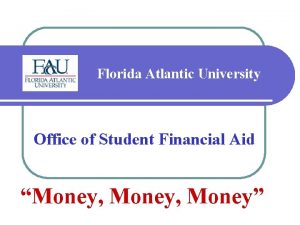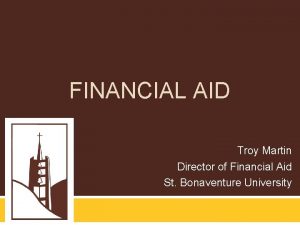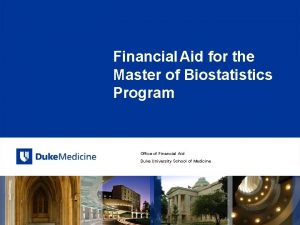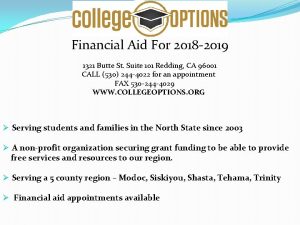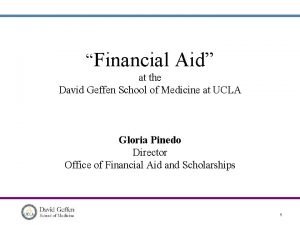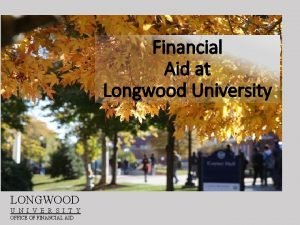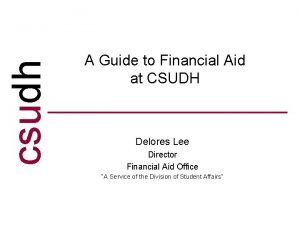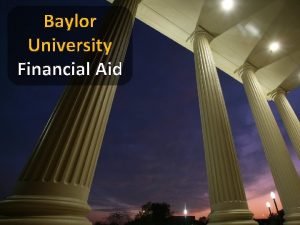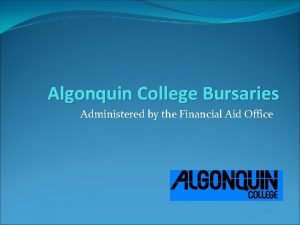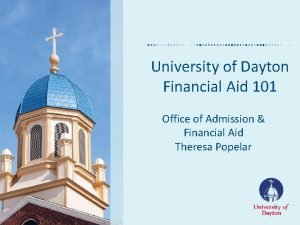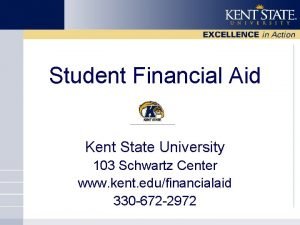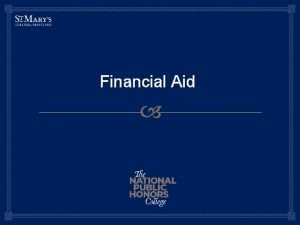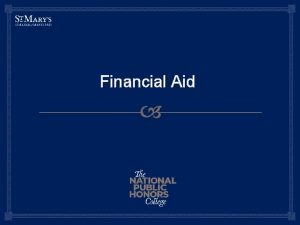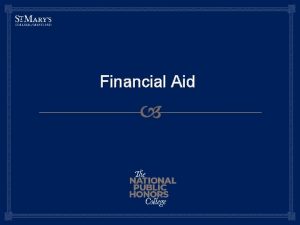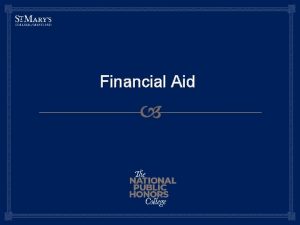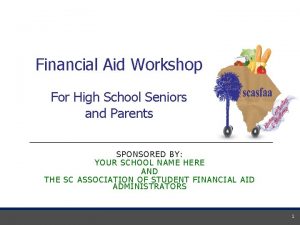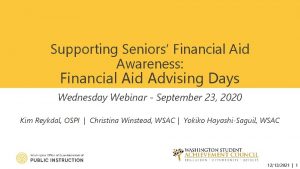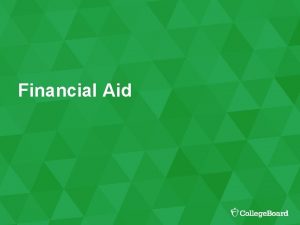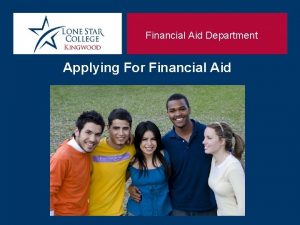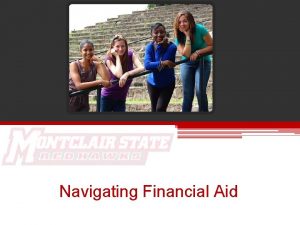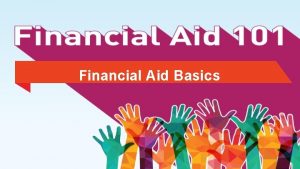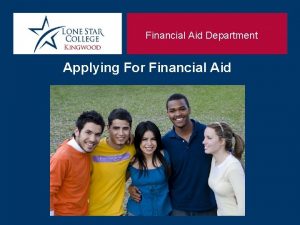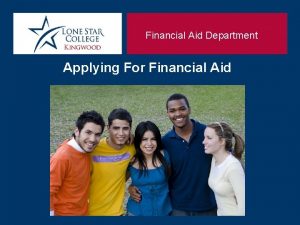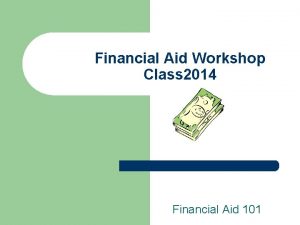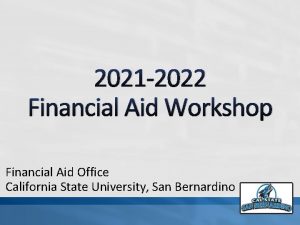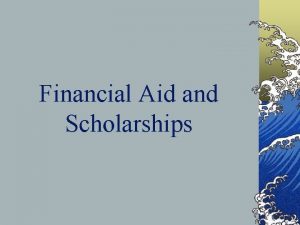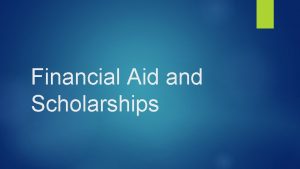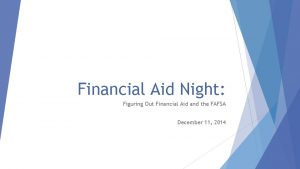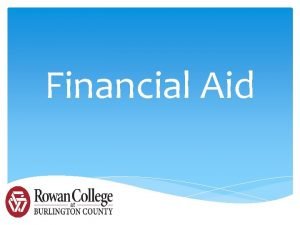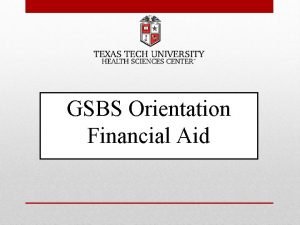Financial Aid Workshop For High School Seniors and




































- Slides: 36

Financial Aid Workshop For High School Seniors and Parents Sponsored by: Greenville County School Counseling and Sirrine Scholarship Program With cooperation from: Clemson University Furman University Greenville Technical College University of South Carolina-Upstate 1

Sirrine Scholarship Required Information: Completed application Counselor recommendation SAR Form Online application as of 2013 Automatic notifications keep you up to date on what still needs to be done 2

Sirrine Scholarship • Online application beginning in 2013 • URL: https: //sirrine. greenville. k 12. sc. us 3

Sirrine Scholarship • Online application beginning in 2013 • URL: https: //sirrine. greenville. k 12. sc. us 4

Applications Free Application For Federal Student Aid (FAFSA) Used by all schools; deadlines vary Institutional Scholarship Application Required by some schools CSS Profile Required by some schools to apply for institutional aid 5

Financial Aid Terms Cost of Attendance (COA) – The estimated cost of tuition, fees, room, board, books, transportation and personal expenses at each school; includes indirect costs Expected Family Contribution (EFC) – A number generated by the FAFSA based on the family’s size, income and assets that is used to determine eligibility Financial Need – The difference between the school’s COA and your EFC Caution: o o Your EFC is not the amount you will pay. Financial aid may not cover your financial need. 6

Financial Need If your Expected Family Contribution (EFC) is 20, 000, your need will be different at each school. School A School B School C $45, 000 $25, 000 $15, 000 Expected 20, 000 Family Contribution 20, 000 Financial Need $5, 000 $0 Cost of Attendance $25, 000 7

Sources of Financial Aid Federal State School Donors (local & national) Military Other Agencies 8

Types of Financial Aid Scholarships – Merit-based aid based on academics or performance that generally requires a 3. 0 GPA or higher for renewal Grants – Need-based aid based on income/assets that generally requires a 2. 0 GPA for renewal Loans – Self-help aid that must be repaid. Employment – Self-help aid that is paid based on hours worked 9

Scholarships University Scholarships Donor Scholarships Palmetto Fellows Scholarship* LIFE Scholarship* Hope Scholarship* *Students must meet SC residency requirements *Students can receive only one type of state scholarship 10

Palmetto Fellows Scholarship $6, 700 Rank in top 6% of high school class (sophomore, junior or senior year) Score 1200 on math/critical reading SAT (27 ACT composite) Earn 3. 5 GPA on uniform grading scale (UGS) Student applies through guidance counselor To retain: Earn 30 credit hours EACH year Earn 3. 0 GPA at home institution AP/IB classes do not count in credit hours for renewal Students who lose the Palmetto Fellows Scholarship may still be eligible for the LIFE Scholarship 11

Palmetto Fellows Scholarship Alternate Criteria Students who do not meet the 6% requirement may still be designated a Palmetto Fellow if they: Score 1400 on math/critical reading SAT (32 ACT composite) and Earn 4. 0 GPA on uniform grading scale (UGS) 12

LIFE Scholarship for Four-Year Colleges $5, 000 Two out of three: Graduate in top 30% of high school class Score a minimum 1100 on math/critical reading SAT (24 ACT composite) Graduate with a minimum 3. 0 GPA on uniform grading scale (UGS) No application process; awarded by college To retain or regain: Earn AVERAGE of 30 credit hours/year Earn all-college 3. 0 GPA AP/IB classes count in credit hours for renewal 13

LIFE Scholarship for Two-Year Colleges $5, 000 OR up to tuition/fees and $300 towards books Graduate with a minimum 3. 0 GPA on uniform grading scale (UGS) No application process; awarded by college To retain: Earn AVERAGE of 30 credit hours/year Earn all-college 3. 0 GPA AP/IB classes count in credit hours for renewal Not renewable for students enrolled in certificate or diploma programs 14

Math and Science Enhancement Applies to certain math and science majors at fouryear colleges Applies to second, third and fourth years LIFE increases from $5, 000 to $7, 500 Palmetto Fellows increases from $6, 700 to $10, 000 Student must complete 14 hours of math, science or combination in the first year AP/IB classes count towards the Enhancement requirements (but not the renewal requirements for Palmetto Fellows) 15

Hope Scholarship $2, 800 Four-year institutions only Graduate with a minimum 3. 0 GPA on uniform grading scale (UGS) No application process; awarded by college Non-renewable To gain LIFE Scholarship in second year: Earn AVERAGE of 30 credit hours/year Earn all-college 3. 0 GPA 16

Grants All require submission of FAFSA Federal Pell Grant Federal Supplemental Educational Opportunity Grant (SEOG) South Carolina Tuition Grant (SCTG) – For private/independent schools South Carolina State Need-Based Grant (SNBG) – For public/state schools South Carolina Lottery Tuition Assistance Program (LTAP) – For two-year schools; not need based 17

Federal Grants Pell Grant Projected $5, 645 maximum for 2013 -14 Supplemental Educational Opportunity Grant (SEOG) Supplement to the Pell Grant Limited funding; based on deadline Amounts will vary by school 18

State Grants SC Tuition Grant (SCTG) For private/independent institutions only Eligibility based on FAFSA by June 30 Projected maximum for 2013 -14 is $2, 800 Freshman must: Rank in top 75% of high school class OR Score 900 SAT (math and critical reading) OR Score 19 ACT OR Earn 2. 0 GPA on the uniform grading scale Renewal requires completion of 24 credit hours and satisfactory academic progress 19

State Grants SC State Need-Based Grant (SNBG) For public/state institutions only Eligibility based on the FAFSA deadline will vary by school Projected maximum for 2013 -14 is $2500; award will vary by school Renewal requires completion of 24 credit hours with minimum 2. 0 GPA 20

State Grants Lottery Tuition Assistance (LTAP) For two-year institutions only Requires FAFSA or a FAFSA waiver, but not needbased Currently $1, 140 per term ($95 per credit hour for part time) Must be enrolled at least half time (six hours) Must be enrolled in a certificate, diploma, or degree program 21

Loans Federal Direct Loan Federal Direct PLUS Loan Federal Perkins Loan Private Educational Loans 22

Federal Direct Loan Student is borrower Maximum freshman loan is $5, 500 Can be partially subsidized Interest rates for 2013 -14 loans: 6. 8% for subsidized (no interest if in school half time) 6. 8% for unsubsidized (interest accrues during school or borrower can elect to make interest-only payments) Student must submit FAFSA, complete Entrance Counseling and sign a Master Promissory Note Six-month grace period before repayment 23

Federal Direct Loan Annual Loan Limits Dependent Student Independent Student Freshman $5, 500 $9, 500 Sophomore $6, 500 $10, 500 Junior $7, 500 $12, 500 Senior $7, 500 $12, 500 Graduate $20, 500 Aggregate (Total) Loan Limits Undergraduate Graduate Dependent Student Independent Student $31, 000 $57, 500 $138, 500 24

Federal Direct PLUS Loan Parent is borrower Maximum loan is up to the remaining annual cost of attendance Interest rate for 2013 -14 loans is 7. 9% Approval is based on absence of adverse credit Can be deferred (with or without interest-only payments) Parent must sign promissory note FAFSA is required, but not need-based aid 25

Employment Federal Work-Study Requires FAFSA; based on need Not paid in lump sum; based on hours worked Institutional Employment Does not require FAFSA Depends on the workforce needs of the school Cooperative Education Student alternates semesters of coursework with semesters of full-time employment in a field related to major 26

Programs for Future Teachers Programs include: South Carolina Teacher Loan South Carolina Teaching Fellow Federal TEACH Grant Awards are $2, 500 to $6, 000 per year Recipients must fulfill teaching obligation Teaching obligation may be restricted to certain locations, subjects, types of schools, and timeframe Must be repaid with back interest if teaching obligation is not fulfilled All programs are not offered at all colleges Teachers may also be eligible for federal loan forgiveness 27

Sample Financial Aid Packages (see next slide) for: Student is an A/B student ranked in the top 20% of class Student scored a 1200 on the math/critical reading SAT and/or a 27 on the ACT Parents are married with an income of $50, 000 Parents have no significant assets other than their home and retirement accounts Family has four members with one in college Student met all deadlines Aid packages are based on 2012 -13 and are estimates only 28

Sample Financial Aid Packages Furman University Clemson University Institutional Scholarship/ Grant $12, 000 Pell Grant $2, 800 Supplemental Grant $1, 000 State Grant (SCTG, SNBG or LTAP) $2, 800 $1, 950 LIFE Scholarship $5, 000 Direct Loan $5, 500 Perkins Loan $1, 500 Work-Study (not a credit on the bill) Remaining outof-pocket (or PLUS Loan) for tuition, room and board $1, 500 $22, 000 USC-Upstate Greenville Tech (@ 15 credits) $2, 000 $2, 800 $5, 000 $5, 500 $1, 843 $2, 500 $6, 000 $2, 000 $0 29

Completing the FAFSA Complete online at www. fafsa. gov Apply early and meet all deadlines Use estimates if tax returns will not be completed soon If parents are divorced, use parent with whom the student lives most Step-parent must be included If student thinks he/she can answer “yes” to a dependency status question, check with financial aid administrator FAFSA must be completed annually 30

Completing the FAFSA If tax returns are filed, use IRS data retrieval tool when filing the FAFSA If FAFSA was filed using estimated income, IRS data retrieval tool can be used to make corrections later IRS data retrieval tool is available approximately 10 days after e-filing Not available if filing MARRIED FILING SEPARATELY Not available if marital status has changed Using IRS data retrieval tool will reduce chances of being selected for Verification (audit) 31

Common Mistakes to Avoid Leaving questions blank instead of listing zeros Listing parent’s information in student’s section Using the incorrect Social Security Number Using a nickname or middle name Not using IRS data retrieval tool Forgetting to include PIN for both student and parent when filing the first time or making corrections later Using www. fafsa. com (requires fee) 32

Verification One third of FAFSAs are selected for Verification by the US Department of Education. The school may ask for federal income tax transcripts (not photocopies of IRS Form 1040) and other documents such as proof of identity, proof of child support, and proof of food stamps. The federal income tax transcript is available from the IRS at www. irs. gov or 1 -800 -908 -9946. Financial aid awards cannot be finalized until Verification is complete. 33

Special Conditions If your family encounters a financial crisis that is not reflected on the FAFSA, contact the financial aid office. Examples of events for which financial aid administrators might use professional judgment: Loss of job Separation/divorce Death of parent or spouse Extraordinary out-of-pocket medical expenses Financial aid administrators are not required to make (and may be prohibited from) some adjustments. 34

Timeline to College (May vary depending on school; does not apply to early decision process) ü August-October Apply for admission; learn deadlines for housing, financial aid, orientation, etc. ; start system for good record keeping ü November Complete FREE online scholarship searches; research local scholarships ü December Use NET PRICE CALCULATOR on schools’ websites ü January Gather financial records; plan to complete taxes early ü February Submit Free Application for Federal Student Aid (FAFSA); attend College Goal South Carolina event on February 23, 2013 for assistance ü March If estimated income was used, update FAFSA after filing taxes by using the IRS data retrieval tool; respond promptly to all requests from schools (tax transcripts, etc. ) ü April Analyze and compare award letters ü By May 1 Commit to school of choice ü May Complete loan Entrance Counseling and sign Master Promissory Note at www. studentloans. gov ü June Assess remaining out-of-pocket expenses; apply for PLUS or private loan if needed 35

Resources www. studentloans. gov Entrance Loan Counseling and Master Promissory Note www. studentaid. ed. gov US Department of Education www. che. sc. gov SC scholarships and grants www. sctuitiongrants. com SC Tuition Grant www. cerra. org SC Teaching Fellows www. scstudentloan. org SC Teacher Loan www. fastweb. com Free scholarship search www. finaid. org Financial aid tools and calculators Your guidance counselor 36
 Dutchtown high school seniors
Dutchtown high school seniors First aid merit badge first aid kit
First aid merit badge first aid kit Greenhill medical centre
Greenhill medical centre High school financial planning program answer key
High school financial planning program answer key High school financial planning program answer key
High school financial planning program answer key High school financial planning program
High school financial planning program Nefe high school financial planning program answers
Nefe high school financial planning program answers Savvy saving seniors
Savvy saving seniors Identification of seniors at risk
Identification of seniors at risk Itslearningccisd
Itslearningccisd 10 minute chair yoga for seniors
10 minute chair yoga for seniors Integrated ethics model
Integrated ethics model Momiji health care society
Momiji health care society Pps humour seniors
Pps humour seniors Welcome back seniors
Welcome back seniors Internet basics for seniors
Internet basics for seniors Cycling seniors
Cycling seniors Writing prompts for seniors
Writing prompts for seniors Food safety for seniors
Food safety for seniors Canadian coalition for seniors mental health
Canadian coalition for seniors mental health Financial aid card
Financial aid card Www southeastern edu financialaid
Www southeastern edu financialaid Snu financial aid
Snu financial aid Texas higher education coordinating board
Texas higher education coordinating board Fscj financial aid office
Fscj financial aid office Twu financial aid staff
Twu financial aid staff Financial aid office fau
Financial aid office fau Troy financial aid
Troy financial aid Duke financial aid office
Duke financial aid office Butte financial aid
Butte financial aid Gloria pinedo
Gloria pinedo Longwood university financial aid
Longwood university financial aid Fafsa csudh
Fafsa csudh Baylor university financial aid office
Baylor university financial aid office Ontario first generation bursary
Ontario first generation bursary Dayton financial aid
Dayton financial aid Michael schwartz center kent state
Michael schwartz center kent state



